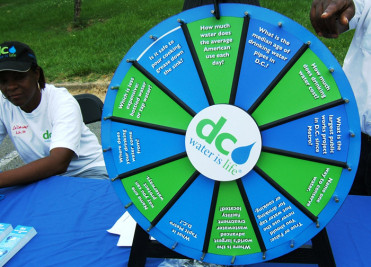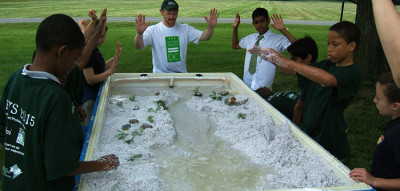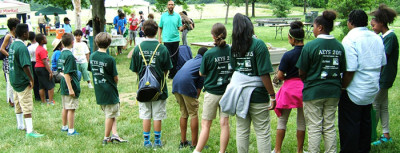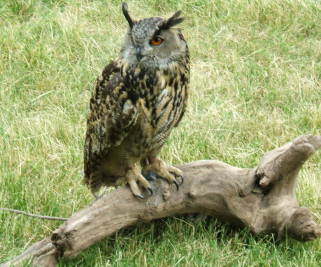Environmental Youth Summit Focuses on Restoring DC’s Anacostia Watershed
Flocks of kids converge on swaths of grass and thick tree clusters under a hazy sky. This is Anacostia Park, located on the majestic, if polluted, Anacostia River, a refuge from the cement, traffic, and bustle of Southeast Washington, DC. The occasion on this May 29th is the 2015 DC Environmental Youth Summit, held not on the more famous Potomac River, but on the Anacostia, often called the forgotten river. Tucked away in the more impoverished and racially segregated part of our nation’s capital, the Anacostia, beset by litter and sewage runoff, is browner in color than its dazzling blue twin, the Potomac.
 “We wanted folks to know more about the Anacostia River,” says Gilda Allen, who was instrumental in founding the Summit in 1995, when it was known as the Environmental Education Fair. Allen, who is now retired, was then an Environmental Education Specialist for the city of DC. “We wanted to provide a meaningful environmental education,” she explains, “geared specifically for young people to make better environmental stewards.” In addition, the Summit aims to show “that the river is really vital to the community in DC, and to talk about water and water quality.” The Anacostia offers the perfect space to display the wonders of nature and the perils and pollution it faces all at once.
“We wanted folks to know more about the Anacostia River,” says Gilda Allen, who was instrumental in founding the Summit in 1995, when it was known as the Environmental Education Fair. Allen, who is now retired, was then an Environmental Education Specialist for the city of DC. “We wanted to provide a meaningful environmental education,” she explains, “geared specifically for young people to make better environmental stewards.” In addition, the Summit aims to show “that the river is really vital to the community in DC, and to talk about water and water quality.” The Anacostia offers the perfect space to display the wonders of nature and the perils and pollution it faces all at once.
In a time when the average kid spends only seven minutes a day enjoying the outdoors, the situation is especially troubling in Southeast DC where parents rarely have the time and resources to take their children into the wild. The Anacostia Youth Summit, which gathers some 400 students from grades four through eight on an annual basis, is an attempt to correct that, to “emphasize the importance of youth voices, celebrate the youth we have worked with throughout the year,” says Trinh Doan, Environmental Protection Specialist for DC’s Department of the Environment.
 The summit gathers kids from schools mainly on the Anacostia watershed, although it welcomes schools throughout the District. Local kids must first submit proposals to compete for environmental prizes. The schools rotate yearly, depending largely on the quality of their proposals. The big moment is when teams from different schools get up to defend their projects. For youth to be “onstage, presenting to colleagues is scarier than being in front of friends,” says Doan. It gives them “a glimpse of public speaking, of being in the spotlight,” building “confidence in themselves.”
The summit gathers kids from schools mainly on the Anacostia watershed, although it welcomes schools throughout the District. Local kids must first submit proposals to compete for environmental prizes. The schools rotate yearly, depending largely on the quality of their proposals. The big moment is when teams from different schools get up to defend their projects. For youth to be “onstage, presenting to colleagues is scarier than being in front of friends,” says Doan. It gives them “a glimpse of public speaking, of being in the spotlight,” building “confidence in themselves.”
This years’ presentations are remarkably sophisticated and thoughtful, discussing projects that identify a problem and suggest a solution. For one group, the problem is that DC air is worse in lower income neighborhoods and the solution is better monitoring to make people aware of it. Another group has documented how water in their neighborhood is polluted, and suggests filtering it with sand and gravel.
 Still another team of kids is concerned with the salt washing into waterways, harming plants and animals and causing dead zones, and suggests an ecofriendly salt as the solution. One group has put together a video that uses tap dancing and rap to challenge people to pick up trash.
Still another team of kids is concerned with the salt washing into waterways, harming plants and animals and causing dead zones, and suggests an ecofriendly salt as the solution. One group has put together a video that uses tap dancing and rap to challenge people to pick up trash.
At the end of the day, the prizes are announced. First prize this year goes to a project called “Oyster” from the Washington Latin Public Charter School and is “a presentation on educating people about oysters and helping others at the marina get oysters to put on their docks,” explains Doan. The winning team receives a $1000 check from sponsors Agrium and Earth Force, to be used for educational purposes.
In addition to the competition, the Summit offers ample hands-on experience and interaction with nature. Students rotate to numerous events, prime among them a boat ride on the Anacostia. Lively presentations and physical activities give vivid instructions regarding stormwater, watersheds, aquatic life, fishing, boating, bicycling, and many other means of appreciating nature.
Participating organizations range from Capital Bee Care to Washington Youth Garden, Anacostia Unplugged to the Anacostia Watershed Society, Moms Organic Gardens, Living Classroom, Clean Air Partners and many others.
 One of the most memorable is the presence of a red-tailed hawk and an owl shown by Daryl Wallace of the Earth Conservation Corps. Wallace’s message to the kids is to respect nature and not to litter, since it “affects these animals and makes into the water,” where it moves up the food chain and ends up in the bellies of fish, birds, and squirrels.
One of the most memorable is the presence of a red-tailed hawk and an owl shown by Daryl Wallace of the Earth Conservation Corps. Wallace’s message to the kids is to respect nature and not to litter, since it “affects these animals and makes into the water,” where it moves up the food chain and ends up in the bellies of fish, birds, and squirrels.
Plastic is pernicious, explains Wallace, and Styrofoam even worse, breaking down into small particles that animals eventually consume. While hawks are finicky and can usually avoid such trash, when they’re hungry enough they’ll eat anything.
As inspiring as it is, the Youth Summit is only one day a year. Yet environmental awareness is an ongoing process. The DC government is therefore involved in a series of youth environmental education programs. “We know one event” isn’t enough, says Allen, so “we work with kids during the year. This is the culminating event.”
Environmental education is now an integral part of the DC school curriculum. Activities include camping trips for all fifth graders, ongoing watershed education, and cleaning litter. The RiverSmart Schools program, often held in an outdoor classroom, includes planting trees and native plants and creating habitat for wildlife. Students also help in designing local stormwater management projects.
 The Youth Summit has become central to DC’s environmental education, with a storied history. Vice President Al Gore dropped in early in the program, while national science educators, including Bill Nye and the Kratt Brothers, have put in appearances over the years. The real stars, though, are the animals, from birds to water snakes and even to humble squirrels, as well as the river itself. This can alter hearts and minds.
The Youth Summit has become central to DC’s environmental education, with a storied history. Vice President Al Gore dropped in early in the program, while national science educators, including Bill Nye and the Kratt Brothers, have put in appearances over the years. The real stars, though, are the animals, from birds to water snakes and even to humble squirrels, as well as the river itself. This can alter hearts and minds.
“It feels good to help the environment,” says Dakoda Dacosta, a Keynote Student Speaker at this year’s summit, “to keep it safe and clean. It has a large effect on what DC will be five or ten years from now.”
“We hope some of the young people make changes in their lives, in the way they conserve water” says Allen. “We hope to teach young people to be a little kinder and a little gentler to wildlife.” In the longer term, the aim is to give young people a focus and a fascination, so that some eventually become policy professionals or environmental scientists. “This is a great time in which we live for the environment,” says Allen, “because people are becoming more aware, parents want their children to know more.”
